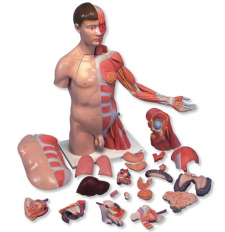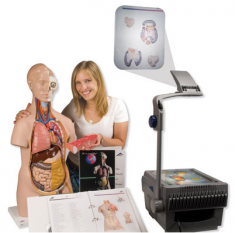The human body is a scientific marvel. Complex and multi-faceted, the human body is composed of amazing organs and awe-inspiring physiological functions. To thoroughly capture all of its components, high-quality anatomical models are carefully built to meticulous standards of realism. Every minute detail is represented in vivid color and rich detail, to provide you with the most accurate representation for your instruction or diagnosis.
Human Torso Anatomy Models
Of all the types of anatomical models, human torso anatomy models are the most detailed. Most critical organs are housed within the trunk or torso. The heart and lungs, located in the upper chest, are protected by the rib cage. The abdomen contains the majority of organs responsible for digestion, including the stomach, small and large intestines, pancreas, liver, and the gallbladder. The abdomen also contains the kidneys and spleen.
Many of the torso anatomy models are hand-painted, to capture even the smallest details. For example, the Deluxe Dual Sex Torso with Muscular Arm mode is a life-size representation of the human torso and features a 6-part muscle arm. This high-quality model is especially suited for the meeting the standards of medical schools. The right half shows the skin, the left half illustrates the superficial and deeper muscles with nerves, vessels and bony structures. The versatility of this aesthetically designed model is rounded off by the exact representation of the internal organs.
1. Instructional Usage
Life size human torso anatomy models provide a realistic representation of the various parts of the human body and internal organs. Highly detailed human torso anatomy models are used by medical institutions to train students and residents on the intricacies of the human body. Doctors and medical instructors employ torso models to illustrate the complicated structure and functions of the internal organs.
2.Teaching Aids For Students
Human torso anatomy models are an excellent study aid for students to gain a deeper understanding of the components and structure of the human body and internal organs. Students will appreciate the opportunity to have access to color-coded, hands-on unisex anatomical models to assist in their studies. Labeled human torso models feature clear views of the vertebrae, spinal cord, spinal nerves, vertebral arteries, lungs, stomach, liver, intestinal track, kidneys, heart, and more.
3. Patient Education Resource
Human anatomical models play an important part in the patient education process. Health professionals can incorporate anatomical models into their discussions with patients and caregivers to assist in the explanation of medical conditions and treatment options. The knowledge gained by the patient and caregivers can help improve their health behaviors and potentially improve their health status. Integrating a life size human torso anatomy model into the patient education process provides the patient with a clearer understanding of the human body and the anatomical structure. Anatomical models are a valuable teaching tool to help demonstrate the various parts of the human body and internal organs.
A Valuable Tool
Understanding the human body is important for medical students and healthcare professionals alike. Anatomical models are some of the best teaching aids. Approximately 65 percent of the population¹ are visual learners, incorporating anatomical models into teaching methods will help support the material covered in lectures and textbooks. When discussing medical procedures and conditions with patients it is equally important to be able to support the discussion with accurate and realistic anatomical models. Whether you are a student studying human anatomy in a biology classroom or a doctor explaining something to a patient, anatomical models are a valuable tool.


Great post! It’s so much more interactive to be able to learn about human anatomy through anatomical models than just a textbook. The diagrams make much more sense when you can visually see it in person. They work great for teaching students as well as educating patients. I also like training with real human anatomy models as well. Really gives you an appreciation for the human body when you see all of the components that makes it function.